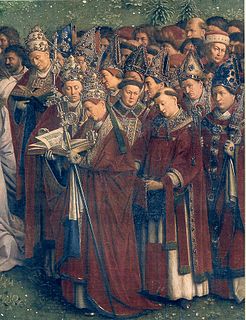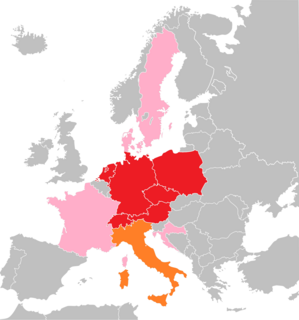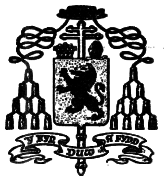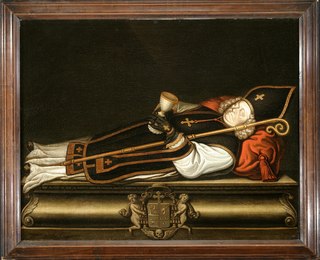The terms Old Catholic Church, Old Catholics and Old-Catholic churches designate "any of the groups of Western Christians who believe themselves to maintain in complete loyalty the doctrine and traditions of the undivided church but who separated from the see of Rome after the First Vatican council of 1869–70".

The magisterium of the Roman Catholic Church is the church's claimed authority or office to give authentic interpretation of the Word of God, "whether in its written form or in the form of Tradition." According to the 1992 Catechism of the Catholic Church, the task of interpretation is vested uniquely in the Pope and the bishops, though the concept has a complex history of development. Scripture and Tradition "make up a single sacred deposit of the Word of God, which is entrusted to the Church", and the magisterium is not independent of this, since "all that it proposes for belief as being divinely revealed is derived from this single deposit of faith."

The Old Catholic Church of the Netherlands, sometimes known as the Ancient Catholic Church, Dutch Roman Catholic Church of the Old Episcopal Order, the Church of Utrecht , or Jansenist Church of Holland, is an Old Catholic jurisdiction originating from the Archdiocese of Utrecht (695–1580). The Old Catholic Church of the Netherlands is the mother church the Old Catholic Union of Utrecht.

The Union of Utrecht (UU), or the Union of Utrecht of the Old Catholic Churches, is a federation of Old Catholic churches, nationally organised from 1870 schisms which rejected Roman Catholic doctrines of the First Vatican Council; its member churches are not in communion with the Roman Catholic Church. The 1889 Declaration of Utrecht is one of three founding documents together called the Convention of Utrecht. Many provinces of the Union of Utrecht of the Old Catholic Churches are members of the World Council of Churches; the UU is in full communion with the Evangelical Lutheran Church of Sweden, the Anglican Communion through the 1931 Bonn Agreement; and, with the Philippine Independent Church, the Spanish Reformed Episcopal Church, and the Lusitanian Catholic Apostolic Evangelical Church through a 1965 extension of the Bonn Agreement. As of 2016, the UU includes six member churches: the Old Catholic Church of the Netherlands (OKKN), the Catholic Diocese of the Old Catholics in Germany, the Christian Catholic Church of Switzerland, the Old Catholic Church of Austria, the Old Catholic Church of the Czech Republic, and the Polish Catholic Church in Poland.
The Ultrajectine tradition is that of the Old Catholic Church of the Netherlands headquartered at Utrecht, Netherlands. Ultrajectine thought holds to the words of Vincent of Lérins's Commonitory: "We must hold fast to that faith which has been held everywhere, always, and by all the faithful." Ultrajectine thought rejects papal supremacy and papal infallibility, and holds to the belief that only the Church in ecumenical council may speak infallibly.

Bishop Franciszek "Francis" Hodur was the founder and first Prime Bishop of the Polish National Catholic Church (PNCC). Ordained by the Roman Catholic church in 1893, Hodur served two parishes in the Scranton diocese before he was excommunicated five years later in 1898 for his release of a National Church program, which called for reformation to canon laws of temporal goods. His excommunication was also a result of his rejection of the dogmas of papal infallibility and supremacy after the Council of Trent. With a congregation of approximately 200 families, he founded the St. Stanislaus Parish in Scranton and celebrated Mass in the Polish vernacular of the congregation, instead of Latin, as was common in the Roman Catholic church. Hodur was consecrated a bishop in 1907 with apostolic succession by the bishops of Old Catholic Church and went on to expand the episcopate of the PNCC to manage diocesan affairs and ordain priests therein. Under Hodur, the church expanded to 245 parishes across the United States and Poland. After his death in 1953, he was succeeded by Leon Growchowski, whom he had consecrated in 1924.

Arnold Harris Mathew, self-styled de jure 4th Earl Landaff of Thomastown, was the founder and first bishop of the Old Roman Catholic Church in the United Kingdom and a noted author on ecclesiastical subjects.

Gerardus Gul served as the seventeenth Archbishop of Utrecht from 1892 to 1920. He is known for his role in assisting the persons who would later found the Polish National Catholic Church in the United States, as well as for consecrating Arnold Harris Mathew, the founder and first bishop of the Old Catholic Church in Great Britain.

The Lordship of Utrecht was formed in 1528 when Charles V of Habsburg conquered the Bishopric of Utrecht, during the Guelders Wars.

Dominique-Marie Varlet was a French prelate and missionary of the Catholic Church who served as vicar general of the Diocese of Quebec. Later, as the Roman Catholic Bishop of Babylon, he caused a schism within the Roman Catholic Church by consecrating four men successively as Archbishop of Utrecht.
The Society of Mercy is a group of Old Catholic. The Society is a descendant of the church begun by Archbishop Arnold Harris Mathew in 1910 and formerly part of the Church of Utrecht. The Society maintains the traditional dogmas of Catholic Christianity while emphasizing the necessity of a pastoral approach.
The Old Roman Catholic Church in Great Britain is an independent Catholic church claiming descent from Arnold Harris Mathew in 1910.

Cornelis van Steenoven was a Dutch Roman Catholic priest who later served as the seventh Old Catholic Archbishop of Utrecht from 1724 to 1725. Consecrated without the permission of the pope, Steenoven was at the center of the 18th-century controversy between national churches and what many considered to be the overreaching powers of the papacy.
Cornelius Johannes Barchman Wuytiers served as the Old Catholic Archbishop of Utrecht from 1725 to 1733.
Petrus Johannes Meindaerts served as the tenth Archbishop of Utrecht from 1739 to 1767. After the death of his consecrator, Bishop Dominique Marie Varlet, Meindaerts consecrated other bishops, such that all later Old Catholic bishops derive their apostolic succession from him.

Walter Michael van Nieuwenhuisen served as the eleventh Archbishop of Utrecht from 1768 to 1797.
Johannes Jacobus van Rhijn served as the twelfth Archbishop of Utrecht from 1797 to 1808.
Johannes van Santen served as the fourteenth Archbishop of Utrecht from 1825 to 1858. He was part of the last attempt of the Church of Utrecht to reconcile with the Roman Catholic Church at that time.
Franciscus Kenninck served as the eighteenth Archbishop of Utrecht from 1920 to 1937.

Andreas Rinkel was a Dutch priest who served as the nineteenth Archbishop of Utrecht from 1937 to 1970.











